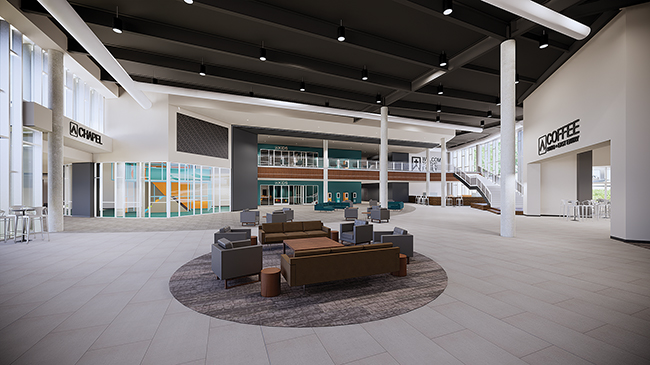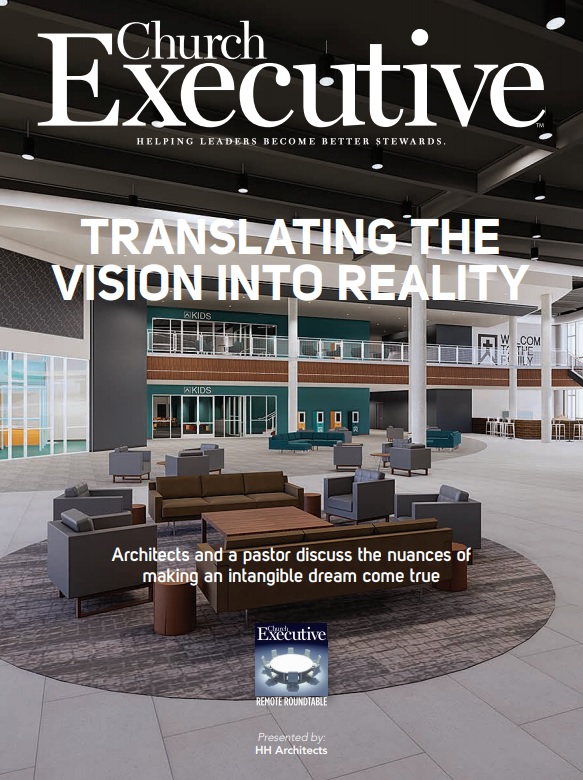
 Architects and a pastor discuss the nuances of making an intangible dream come true when it comes to church facilities
Architects and a pastor discuss the nuances of making an intangible dream come true when it comes to church facilities

President & CEO
HH Architects
(Dallas, Texas)
Church leaders typically refer to their building projects in terms of “vision.” Why is it so important for an architect to understand this language?
Bruce Woody: It’s important that the architect understand the vision of the church leadership. In that way, when the building is complete, it can fully reflect the vision in every aspect, from function to aesthetics.
Melanie Hanna, RID NCIDQ: Yes; regardless of the project type, casting a clear vision is key to strategic planning for the future. Building projects are often referred to as “vision” because they are a tangible step towards where God is leading the church.
Mark Ashcraft: How often to you begin a road trip by just getting in the car and driving? You think about where you want to go, what you need to accomplish, and plan the best route to get you there.
Vision creates opportunity to gather around an idea and move in the same direction. It creates clarity with easy-to-understand goal and / or objectives.
With faith-based projects, the funding usually comes from sacrificial giving. Most people want to know the “why” as well as “what” when they are entrusting their money to a building project. As an architect, it is easy to get trapped in the “what” —

Senior Associate, Director of Design Strategy
HH Architects
spaces needed, their layout, what they will look like — but we must always look to the vision messaging when developing a project to keep the focus on “why” the project exists.
What’s more effective: selling classroom space or casting a vision for reaching the next generations for Christ with said classroom space? The Gospel message is one of hope. If we only think of the “what,” we can miss the larger purpose of the project.
What are some reliable indicators it’s time for a church to consider a building project?
Ashcraft: Are your facilities relevant? If you look around your campus with a critical eye and don’t seem relevant to current expectations — what people see every day everywhere else — you have a problem. No matter how great your messaging, people are visual creatures, and it will be another challenge to overcome.
If your ministry vision is being dictated by your space — again, you have a problem. Ministry should always drive the design of your space. Growth. If you have increased the number of services, added additional education hours, and so on.
Woody: When you begin to sense the building has become a hindrance to growth, it’s necessary to consider how your facilities must be adapted, expanded or changed to correct or address this issue. This can occur because of lack of actual space, or because of lack of appropriate space that is relevant to and reflects the desired vision and ministry of the church today. What we do is about realigning the facilities with the current vision.

Creative Director
HH Architects
Sometimes a pastor will ask if we’d rather know how the church is doing ministry now, or how it wants to do ministry in the future. We always want to know the latter. Otherwise, there’s a risk of the facilities dictating the ministry when it should be the other way around.
Hanna: I agree, and I’d say that space, functionality and age are the most common key factors when considering whether to remodel a facility or build new. Churches have to take an honest look at how their current facilities are driving their ministry in terms of space and functionality for not only the current needs but the generations to come.
Josh, what were the indicators that it was time for your church to build?
Josh Merriott: We began to feel a heightened awareness about the future and how our facilities were often a barrier to ministry. Our five different buildings didn’t function together strategically, and it would take more than 20 minutes for some families to complete the drop-off process on a Sunday morning.
To make matters worse, our student ministry met in a building that required them to ride a shuttle or cross a busy street.

Senior Associate Pastor of Communications and IT (Co-lead for the “Generations Project” construction/renovation project)
Cross City Church
(Euless, Texas)
Repeatedly, we saw how these challenges were holding us back.
When we started, we didn’t know exactly what the project would look like, but we knew we had to do something if we were going to continue to be effective in reaching people.
Before approaching an architect, what key questions should a church leader ask himself or herself about the church project’s vision? And how might the practical answers to these questions be realized in the design?
Hanna: A church leader should first ask: As a church, what goals are we trying to accomplish? Do these goals strategically align with the steps required to get to vision?
The heart of Josh’s church — Cross City Church in Euless, Texas — is focused on reaching all people. The Generations Project: Building for the Future is a reflection of the church’s preparations to create a facility that helps them reach people now and years to come. It focuses on improving guest experience and engagement.
As Senior Pastor John Meador says: ‘When God opens unusual doors of direction and provision that no one else can open, it inspires confidence to move forward.”
Ashcraft: Is our vision clear and easily understood? Can the average person quickly grasp where we are intending to go, what is required, and (most important) what we are asking of them?
How will we craft our messaging to create this necessary clarity to get people invested and build momentum?
Does our project vision include both the “what” and “why” behind? Does it include “how” we think we can get there?
Tennessee’s First Baptist Cleveland is a good example. Its vision, “Generations,” is about the long-term purpose of making Kingdom-minded believers and disciples who make disciples. It is a continuation of their initial vision cast in 2008, expanding on their successful first phase, and it focuses on the impact across all ages that the current project will create.
Woody: What message is our current building sending to the community? What ministry needs are not being fulfilled with current space? What ministry needs would we like to provide that the current facility does not? And then, how can we message that with the architectural design? How can that message be congruent?
We use the term ‘congruent’ because different buildings on the same campus can send a different message, and that’s OK. What’s more important is that your overall message — from your website to your physical campus — is congruent with the church’s design. If not, the average visitor, guest or member will see that as a mixed message.
Josh, tell us more about Cross City Church’s vision for its building project.
Merriott: We envisioned a place that would help us connect with our community and with each other. The design of the Commons space was crucial, and HH nailed it. They designed a big, open, welcoming area with a clear front door, comfortable seating, coffee, and places for kids to play. Our people will love it, and we believe that they’ll invite people to join them. Our community will have a good reason to come in during the week as well.
We are a multigenerational church, and we also hoped that that our generations would feel connected with each other. In the design process, we replaced a lot of walls with glass so that we can see the ministry happening with our kids and students. Of course, we wanted our kids and students to have places where they could grow in their relationship with God for years to come.
The design works well for today and gives us flexibility for the future. It’s a great marriage of form and function, which was important to us from Day 1.
“We believe it’s imperative to envision what could be, even when this is seemingly out of reach. Initially, it’s important not to restrain the vision.”
— Bruce Woody
Was it important that the architect your church chose was familiar with this vision — and designing churches, in general?
Merriott: It was crucial to find a partner in design who would take the time to understand us and our mission. We knew that if we could launch at the same trajectory, we could hit the same target. That relationship between us and the architect was too important to take lightly, so we set out from the beginning to find a firm that aligned with our vision and values.
We had become familiar with the work HH had done, so we were already highly interested in working with them. However, their attention to us prior to the decision made a significant impression. Their initial ideas were spot on — largely because they listened so well.
This project was the first new construction we had done in about 20 years, and we had big dreams of what we wanted to accomplish. It was clear after the initial pass that the size of the project was beyond where we needed to go. HH helped us quantify the costs of each element so that we could prioritize and move forward.
That calls to mind an all-too-common problem: what if a church’s vision exceeds its capabilities?
Woody: We believe it’s imperative to envision what could be, even when it might seem to be out of reach. Initially, it’s important not to restrain the vision. We want to start with a blank slate.
Too often, for pastors, value engineering comes to mind way before it should, and they might start ‘attacking’ the things that will cause immense value reduction, but drive minimal savings — finishes and fixtures, for example. Those are the parts everyone sees when they walk in. We’d rather plan further in advance to retain the best possible people-facing elements, while still adhering to budget.
HH Architects’ strength is in leading and guiding an owner to take steps towards achieving a balance of desired goals, within their budget, that exceeds expectations. That’s a guiding principle for us: exceeding expectations.
Ashcraft: Right — within reason, a church’s vision should encourage stretching beyond its capabilities. A vision should be hopeful; it should be exciting; it should be attainable. If leadership feels their vision is a stretch, but still attainable, craft the messaging around the final goal, but show how it can be delivered in reasonable steps as resources are obtained.
We were created to be dreamers, asked to step out in faith — while being good stewards of what has been given.
Hanna: All true. Visions are meant to be an overarching dream, giving a sense of hope and purpose. To reach that vision, reasonable goals — both short-term and long-term — need to be set to meet the church’s provisions and limitations. Once a church’s goals are set, they can transform their vision into energy.
Rachel Hollis, bestselling author of Girl, Wash Your Face and host of one of the most successful podcasts in the world, states: “A goal is a dream with its work boots on. A goal is a dream you’ve decided to make real. A goal is a destination you’re working towards instead of an idea you’re only considering or hoping for.”
“The design of the Commons space was crucial, and HH nailed it. They designed a big, open, welcoming area with a clear front door, comfortable seating, coffee, and places for kids to play. Our people will love it, and we believe that they’ll invite people to join them. Our community will have a good reason to come in during the week as well.” — Josh Merriott
Again, related to vision, has your architectural team observed commonalities in church project visions in recent years?
Ashcraft: I think what you are seeing today is the church getting back to its Gospel roots. There is an acceleration to the expectations of what church is, largely from our collective experiences during the pandemic. What we saw with the pandemic was the need to be adaptable on the fly, which is really a reflection of a trend towards flexibility. Planning for unknowns and building in the ability to pivot when necessary is a must moving forward.

Other commonalities I’ve witnessed include a desire to be relevant, to be the light in the community we are called to be. This includes becoming a community central point, offering opportunities throughout the week — whether to the business community, young families, and so on. Being part of the community means right-sizing to whatever marketplace you serve, getting back to the neighborhood church focused on serving with a missional orientation.
We are seeing a desire for an improved experience on campus — in worship, in fellowship, in serving. There is family-first driver as a nucleus to a stronger community. What used to be “stay in your respective areas” (seniors, youth, adults, etc) now involves reaching across generations, creating opportunities to engage and interact every time you dawn the doors.
Hanna: 2020 proved to be a year of refocus for churches, communities and families. The common theme that is most intriguing to me is the acceleration on the focus around building community and being inclusive to all generations. Churches are starting to think out of the box, not only on how they operate their facilities but how the community can use their spaces during the week.
We are seeing an uptick of programming for outdoor event space, multipurpose, engaging nooks for the new remote worker during the week which include pods or coffee shops, safe-havens for parents to bring their kids (such as splash pads, outdoor play, or indoor structured play), and recreational facilities to promote healthy living. All these spaces are being occupied during the weekdays serving the communities they are in while creating an open invitation to learn more about the Gospel.
Ashcraft: As far as casting visions, what I find interesting is how the messaging is being crafted and delivered. It has always been a matter of faith and trusting in what God will do, but there is a humbleness today I think has been missing. It is a very purposeful message getting back to the Gospel, focusing on why a project is necessary and what it will enable the church to do: reach people for Christ. There is a deeper understanding that the architectural design or buildings themselves are simply the fulfillment of a ministry vision.
— Reporting by RaeAnn Slaybaugh


